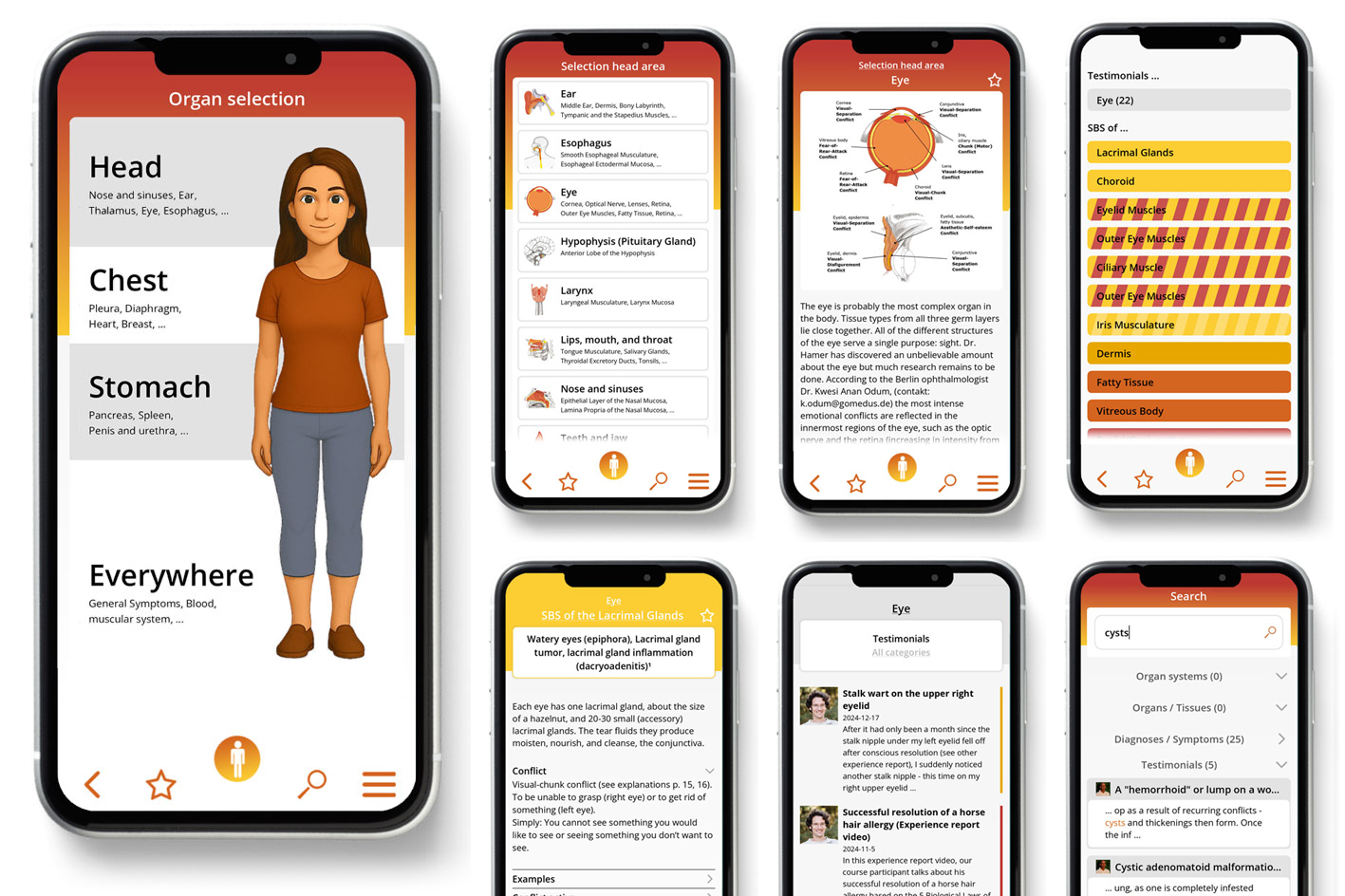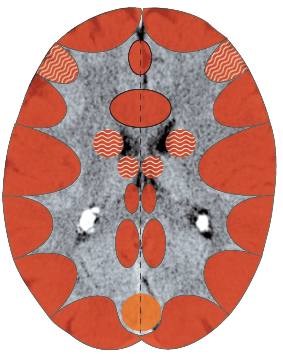 The information on this site is from one of the most famous books about the New Medicine (GNM / 5BN): "The Psychic Roots of Diseases" by Björn Eybl. Since September 2025, it is available in the form of an app with many additional features.
The information on this site is from one of the most famous books about the New Medicine (GNM / 5BN): "The Psychic Roots of Diseases" by Björn Eybl. Since September 2025, it is available in the form of an app with many additional features.It was written in german and was translated into more than 10 languages already. German is not freely available, as the rights are held by a publisher, but all these translations are available as ebooks / PDFs for free, as a gift of Björn for you, for the New Earth, for a new time.
In cooperation with Björn, it is splitted on "Disease is Different" into the sections by organ systems and combined with the real cases of our international testimonial / report archive of the related organ system.
LARYNX
The larynx lies at the junction of the throat and the windpipe. It is made up of three cartilages, which are bound with muscles and ligaments. One protrudes as the so-called Adam‘s apple.
The two tasks of the larynx
1. Swallowing: when we swallow, the epiglottis closes the windpipe and leads the chewed food into the esophagus.
2. Making sound: with the help of the vocal chords, the larynx plays a role in the production of sound and language. The inner surfaces of the larynx and vocal chords are lined with squamous mucous membrane, under which lies voluntary (striated) and involuntary (smooth) muscles. The larynx is small. However, from the viewpoint of the 5 Biological Laws of Nature, it is an important organ, since conflicts of the larynx belong to the spectrum of territorial conflicts.
Larynx Mucosa
Shock-fright conflict or
speechlessness conflict

Larynx Muscle
Shock-fright conflict or
speechlessness conflict
(motor)

Inflammation of the larynx (laryngitis), cancer of the larynx
(larynx carcinoma or papilloma)1
| Conflict | Shock-fright or speechlessness conflict or territorial-fear conflict (dependent on “handedness,” hormone levels, and previous conflicts). One is startled because of a sudden threat or noise. One cannot speak loud enough or scream (teacher and football coach conflict). “So scared I couldn’t scream.“ “To be scared to death.“ “Deer in the headlights, (rendered rigid and mute).“ “The words are stuck in my throat.“ Typically, the shock-fright conflict is the feminine-passive reaction to a threat. The territorial-fear conflict would be the male-active reaction. (Females tend to react with passive fright while males tend to react by attacking). |
|---|---|
| Examples | The following are examples of shock-fright conflicts: (examples of territorial-fear conflicts see pp. 200) ➜ In a conference, somebody urgently wants to say something, but is unable to say a word. ➜ Someone is put under pressure (be it for time or an appointment).  A pregnant woman drives head-on into another car. She is thrown out of her car. She greatly fears losing her baby = shock-fright conflict. Degradation of mucosa cells in the active phase, restoration in the repair phase = laryngitis. (See Gisela Hompesch, Meine Heilung von Krebs, p. 57) A pregnant woman drives head-on into another car. She is thrown out of her car. She greatly fears losing her baby = shock-fright conflict. Degradation of mucosa cells in the active phase, restoration in the repair phase = laryngitis. (See Gisela Hompesch, Meine Heilung von Krebs, p. 57) A person is surprised with bad news over the telephone = shock-fright conflict. (Archive B. Eybl) A person is surprised with bad news over the telephone = shock-fright conflict. (Archive B. Eybl) The husband of a 60-year-old, married, left-handed retiree has been suffering with heart problems for the last several years. In the last months, they have been getting worse. Now, her husband is constantly asking the patient to do things and take care of things for him. She feels that her husband is robbing her of her personal freedom and time = shock-fright and territorial-fear conflict. The problem is that he is really starting to need more care and cannot manage by himself — her personal freedom is getting smaller and smaller. As her husband is sent off to a rehab-spa for a few weeks, the patient comes into healing (at least for the time being) > laryngitis and tightening of the larynx. (Archive B. Eybl) The husband of a 60-year-old, married, left-handed retiree has been suffering with heart problems for the last several years. In the last months, they have been getting worse. Now, her husband is constantly asking the patient to do things and take care of things for him. She feels that her husband is robbing her of her personal freedom and time = shock-fright and territorial-fear conflict. The problem is that he is really starting to need more care and cannot manage by himself — her personal freedom is getting smaller and smaller. As her husband is sent off to a rehab-spa for a few weeks, the patient comes into healing (at least for the time being) > laryngitis and tightening of the larynx. (Archive B. Eybl) Four years ago, an entrepreneur turns over his company to his successor. He steps down just one step at a time, since the continuation of his life‘s work means a lot to him. One day, an old business friend with whom he has worked closely for the last thirty years contacts him and regretfully tells him that he wants to end their cooperation at the end of the year = shock-fright conflict (larynx), territorial-marking conflict (bladder) and chunk conflict (colon). Four days later, he comes into healing because he makes it clear to himself: “It is no longer your firm. It‘s none of your business. And it‘s not your fault, so don‘t drive yourself crazy!“ (See www.germanische-heilkunde.at) Four years ago, an entrepreneur turns over his company to his successor. He steps down just one step at a time, since the continuation of his life‘s work means a lot to him. One day, an old business friend with whom he has worked closely for the last thirty years contacts him and regretfully tells him that he wants to end their cooperation at the end of the year = shock-fright conflict (larynx), territorial-marking conflict (bladder) and chunk conflict (colon). Four days later, he comes into healing because he makes it clear to himself: “It is no longer your firm. It‘s none of your business. And it‘s not your fault, so don‘t drive yourself crazy!“ (See www.germanische-heilkunde.at) |
| Conflict-active | Functional limitation, cell degradation later in the squamous mucosa or the vocal cords. Simultaneous slackening of the underlying, according to Dr. Hamer, striated musculature. The voice may be weakened or altered. The conflict-active phase, however, usually proceeds without symptoms. No pain. |
| Bio. function | Through limited vocal ability and poor enunciation, one withdraws and has time to think (passive reaction). |
| Repair phase | Restoration of the larynx mucosa = laryngitis or cancer of the larynx: swelling, reddening, pain, alteration of the voice, rough voice, hoarseness or loss of voice. Strong swelling: the difficulty breathing in, along with syndrome. Cough due to “healing-itch.“ Often, recurring—conflict. |
| Repair crisis | Coughing attacks involving the larynx musculature, pain, feelings of being cold, possibly chills. |
| Note | Cancer of the larynx is diagnosed in the repair phase. Usually in combination with syndrome. |
| Questions | When did the inflammation of the larynx begin? (A territorial conflict must have been resolved shortly before this. E.g., through a vacation, reconciliation/discussion, a reunion). What was stressing me before this? What was I unable/not allowed to say? Was this the first episode? (If no, then work out the original conflict, because the later episodes are based on this one). What has conditioned me, making me unable to deal with the issue? (Early experiences in childhood, the mother’s stress during pregnancy/birth or ancestral stress in similar situations > listen to the ancestors’ story. Which new attitude is called for? Am I ready to leave the past/old issues behind me? |
| Therapy | The conflict is resolved. Support the healing. If recurring, find out what the conflict and conditioning are and resolve them. Guiding principles: “It can‘t cost me more than my head.“ “I am calm, for I trust in my divine guidance.“ “Next time I‘ll speak freely.“ Walks in cold air. Compresses with curd cheese or salt water. Tea: mallow (Malva sylvestris), blueberry, lungwort, sage with honey. Schuessler Cell Salts: No. 3, 4 and 8. Colloidal silver internally. Vitamin D3 (daily dose of cod liver oil). Hildegard of Bingen: horehound and mullein-fennel special recipe |
Vocal cord polyps
Same SBS as above. The main symptom of vocal chord polyps is persistent hoarseness. Sometimes cough.
| Phase | Recurring—conflict — persistent repair: excessive restoration of the mucosa > growth of vocal chord polyps. |
|---|---|
| Therapy | Questions: see above. Find conflict and conditioning and resolve them so that the persistent repair comes to an end. Possibly removal via surgery, should the conflict resolution not change anything. |
Stuttering (stammering)
| Conflict | According to Frauenkron-Hoffmann: One is afraid (shock-fright), but doesn’t scream — doesn’t let it out. |
|---|---|
| Bio. function | Winning time — one has more time to give an answer. |
| Phase | Conflict-active. The impulse to stutter comes exclusively from the brain (no organ changes). |
| Therapy | Questions: see above. Determine and resolve the conflict and conditioning (e.g., ancestors didn’t put things into words, repressed important words). In a regression, the screaming in the specific situations should be made up for. > Good prospects for recovery, because the brain’s “switch” must only be flipped. |
1 See Dr. Hamer, Charts p. 124

Constriction of the larynx — laryngeal asthma1
With asthma or constriction of the larynx, inhalation is impaired. This leads to prolonged and heavier breathing (gasping for air when inhaling). The SBS of the vocal cord musculature — what we’re talking about here — is often coupled with an SBS of the laryngeal mucosa. In this case, there is both laryngitis and asthma at the same time.
| Conflict | Motor shock-fright, speechlessness or territorial-fear conflict and additionally an active conflict on the opposite side of the cerebral cortex. (For examples see: p.193.) |
|---|---|
| Conflict-active | Cerebral cortex—controlled restriction of innervation. Motor paralysis. Simultaneously, cerebral white matter controlled cell degradation from the laryngeal muscles (muscle necrosis). > Muscle weakening > end result “weak voice,“ (usually unnoticed). |
| Bio. function | Widening of the laryngeal lumen through relaxed laryngeal musculature in order to breathe better. |
| Repair phase | Restoration of the laryngeal musculature and return of innervation. Possibly laryngitis at the same time. |
| Repair crisis | Laryngeal asthma attack: coughing cramps or constant tension of the laryngeal musculature lasting from a few minutes to several days; feeling of being cold. |
| Note | The attack occurs only when the opposite right half of the cortex is conflict-active or also in the repair phase crisis (= constellation). It comes to a life-threatening “severe acute asthma” if the bronchial-muscular area (right cortex) is in an repair phase crisis at the same time as the larynx muscle area. With allergic laryngeal asthma, a conflict starts up briefly due to a trigger (CM: “allergen“). In the repair phase crisis, there is another asthma attack. |
| Therapy | Questions: see previous page. Determine the conflict and conditioning and, if possible, resolve them in real life. Guiding principle: “I am quiet and calm and trust in my guidance.“ Walks in cold air. Shred and eat radishes or hollow out radishes, fill with brown sugar or honey and swallow the juice that comes out. Vitamin D3. MMS (see p. 68). Tea: horehound, hibiscus, raspberry leaves, cowslip, English plantain, coltsfoot, Iceland moss, violet with honey. Bach flowers (see p. 59): rescue drops, aspen, cherry-plum. Cayce: mix horehound syrup with whiskey and swallow in small doses. CM: inhalers (ingredients cortisone, anticonvulsants): Useful for acute attacks. Long term use is not recommended because of side effects. |
Cough coming from the larynx, laryngitis with cough (croup = diphtherial
laryngitis, pseudocroup = subglottic-stenosing laryngitis)1
Same SBS as above (conflict constellation). According to CM, croup and pseudocroup differ by the fact that for the “real croup“ one can prove a diphtheria bacteria.
Through the New Medicine, we know that one could prove bacteria even if it is called pseudocroup.
Exanple
 The mother of a 3-year-old girl came into my practice alone. At 8-months-old, her little one had a cough that lasted a few days. Since then, the cough had returned every few weeks, and lately it had been even more frequent. These coughing fits usually lasted from 11 at night to 3 o’clock in the morning, and the mother was becoming increasingly exhausted. Conflict history: Her relationship was already going downhill during her pregnancy. She finally moved out when her daughter was 2. = Shock-fright territorial conflict due to constant parental fighting and eventual separation. Note: The little one’s persistent territorial conflict intensified after the separation, because the child felt her mother’s aversion/mistrust. The result: Increased coughing fits. Visitation: The daughter is always very happy when her father comes and picks her up, but the mother won’t yet allow her to sleep at her ex’s house. Conditioning: Her parents have a bad marriage (the little one’s grandparents). Therapy: After our conversation, we performed a meditation: We went to her mother in her mind and I said these words for her, “I also have a child now too, dear mother. And, I have become like you — I also couldn’t accept my partner — just like you mother. I want to change that now.” Then, we went to the girl’s father. We saw past his shortcomings and into his divine center. “I accept you exactly as you are.” Homework: She should reestablish the love and trust she has for him and allow the child to spend the night in his home as soon as possible. (Archive B. Eybl)
The mother of a 3-year-old girl came into my practice alone. At 8-months-old, her little one had a cough that lasted a few days. Since then, the cough had returned every few weeks, and lately it had been even more frequent. These coughing fits usually lasted from 11 at night to 3 o’clock in the morning, and the mother was becoming increasingly exhausted. Conflict history: Her relationship was already going downhill during her pregnancy. She finally moved out when her daughter was 2. = Shock-fright territorial conflict due to constant parental fighting and eventual separation. Note: The little one’s persistent territorial conflict intensified after the separation, because the child felt her mother’s aversion/mistrust. The result: Increased coughing fits. Visitation: The daughter is always very happy when her father comes and picks her up, but the mother won’t yet allow her to sleep at her ex’s house. Conditioning: Her parents have a bad marriage (the little one’s grandparents). Therapy: After our conversation, we performed a meditation: We went to her mother in her mind and I said these words for her, “I also have a child now too, dear mother. And, I have become like you — I also couldn’t accept my partner — just like you mother. I want to change that now.” Then, we went to the girl’s father. We saw past his shortcomings and into his divine center. “I accept you exactly as you are.” Homework: She should reestablish the love and trust she has for him and allow the child to spend the night in his home as soon as possible. (Archive B. Eybl)
| Therapy | Questions: see: p.194. As necessary, mucolytic and expectorant medications (secretolytics, expectorant). Dramatic coughing fits: remain calm. If nothing helps and if necessary, administer cortisone (inhaler). Note: Most synthetic cough syrups contain the morphine derivative codeine (addictive). |
|---|
1 See Dr. Hamer, Charts p. 124
Diphtheria
According to CM, diphtheria is caused by the poison (toxin) of the Corynebacterium diphtheriae. The clinical picture is diverse: larynx, pharynx, nose and tonsil infection, swelling of the lymph nodes and fever.
The diagnosis “diphtheria“ doesn’t bring us very far. A more sensible course, like always, would be to examine the patient’s symptoms and determine the conflicts.
Phase: one or more different SBSs in the repair phase.
All experience reports on the organ system «Larynx» from the International Report Archive:
| Author | Title and Overview | Keywords | ||||
|---|---|---|---|---|---|---|
 | 2025/10/17   Hoarseness or loss of voice caused by recurring speech anxiety conflicts | Hoarseness, loss of voice, speech-anxiety conflict | ||||
 | 2025/09/19    Пожилой человек исцелился от тяжелейшей аллергии на мёд, тянувшейся с самого детства, совершенно не помня своего конфликта после того как прислушался к мудрым словам пасечника о пользе мёда | мед, аллергия | ||||
 | 2025/02/08   My husband and I live separately and my children (20 and 16) live alternately with me and their father. We had agreed on which days they would be with whom during the holidays. Now, like many times before, their father hasn't kept to this | |||||
 | 2024/03/22   I suspected a strange car in our parking lot. As I drove closer, I saw that my parking space was free and I could park without worrying. Based on my perception, I came upon an old association with physical symptoms for a few days. The morning after, a sore throat started for 2 days. On the 2nd day there was a watery nose on the left. On the 3rd day the discharge became purulent, only on the left. Now it is the 6th day and the nose is still purulent. | Weather, perception, territorial fear | ||||
 | 2024/03/04   I (right-handed woman, 39) spent a few hours in lively conversation with my brother-in-law during the Corona period. The next day he called me and said that he was sick and had a positive corona test ... | |||||
 | 2023/03/31   A friend (59) reports that she has been suffering from chronic hoarseness and daily nightly sore throats for several years. Countless visits to ENT doctors have produced absolutely nothing. A gastroscopy for suspected reflux was also unsuccessful ... | |||||
 | 2023/03/07   A sore throat sets in just a few minutes after a soothing conversation, followed by hoarseness and coughing within the next few days. | |||||
2022/06/05    This is an experience report from our family from the summer of 2022. In the boy's school, every child in the first grade was supposed to prepare and give a presentation. For him, this was a huge challenge in the new class and he worried about it slightly for weeks or even months and kept putting it off. | Prediction, territorial-fear conflict, cough | |||||
 | 2021/07/25   A mother comes for treatment and tells me that she is very worried about her 4-year-old son because he is highly allergic to nuts. He has already had to go into intensive care twice due to shortness of breath or swelling of the airways ... | Allergy | ||||
2021/05/07    Massive symptoms in the context of the corona crisis with cause in the compulsory masking measures and orthodox medical "Covid-19" diagnosis. | ||||||
 | 2019/05/26   A caesarean section birth that is perceived as dramatic, in connection with which the mother has suffered a fright or speechlessness conflict. After resolving this situation, the daughter begins to speak after a few days. | Speak | ||||
2018/11/18     Ms. M sang a lullaby to her 4-year-old son in November 2018 – her voice was fully functional. The next song she sang normally for the first couple of minutes, and then her voice suddenly disappeared. |
